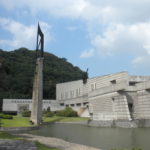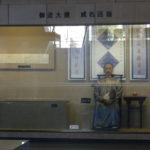Cixi
East Asian calligraphy is a form of calligraphy widely practised and revered in the Sinosphere. This most often includes China, Japan, Korea, and Vietnam. The East Asian calligraphic tradition originated and developed from China. There is a general standardization of the various styles of calligraphy in this tradition. Calligraphy has influenced ink and wash painting, which is accomplished using similar tools and techniques. Calligraphy has also led to the development of many forms of art in East Asia, including seal carving, ornate paperweights, and inkstones.
Lianzi 练字 practicing character (writing) was part of every kid’s growing up routine. Long before my first grade, my Yeye watched over me like a hawk while I held a brush and traced the hollowed Chinese characters on the practice books, just as the kids in the west would trace the alphabets with the dots or broken lines. Chinese has a terrible deal in terms of written language: 2,000 individual characters are needed for a rudimentary education that enables one to read .. vs 26 alphabets .. hmmmmm ..
 Chinese all appreciate a good penmanship. I still do, even nowadays when the key boards replace most writing.
Chinese all appreciate a good penmanship. I still do, even nowadays when the key boards replace most writing.
慈禧赐刘秉璋手书 “福, 寿” 字
Empress Dowager bestows Liu Bingzhang “good fortune/blessing”, and ‘longevity”
The two diamond shaped calligraphy were bestowed to Liu from Cixi 慈禧, a common practice exercised by the Emperors. Gifting of calligraphy is still widely popular in China, very much sought after and appreciated. According to Uncle Shanlin, as late as 1960s, just before Culture Revolution, they had many calligraphy from Cixi laying around in the house and no one gave them an iota. Then proff, all of sudden the red guards came and the calligraphy were all gone with other stuffs.
There wasn’t any footnote at the museum so I don’t know IF
- the two diamond sheets were actually from Qing Dynasty. After so many years, especially the Cultural Revolution (1966-1976), the chance of surviving is very slim.
- the two characters were actually inked by Cixi (1835
Zhenhai Defense Museum 镇海纪念馆

镇海口海防历史纪念馆 Zhenhai Coast Defense History Museum; opened Oct 1997; reopened Sept 2011.
Zhenhai (Ningbo)
The government wanted to honor Liu Bingzhang’s legacy and celebrate the rare triumph he extracted out of a great power in Qing Dynasty..
The drive from Shanghai to Ningbo was about 3 hours and I slept most of the way. So I missed the 22 miles long Hangzhou Bay Bridge completely. As soon as we hit the town, the back wheel was out. The driver stopped a taxi with a passenger sitting in the front to take me to the hotel. First I thought they were friends or knew each other but after the driver dropped her off he casually commented on her status:
Mistress.
I wondered how did he know .. then we pulled into the circular drive at the Sheraton.
My first business of the day was visiting the museum. I took a taxi. It’s about 30 minutes ride. The driver offered me a round trip deal for RMB180 yuan (about US$30 at exchange rate of 6). I took it because probably I had to since there wasn’t any taxi at the museum. It was early afternoon, the drive was smooth without traffic. Streets were relatively clean. The city is being developed but the flat landscapes was not dotted by cranes. We passed the Ningbo University. The drive mentioned it’s founded by their native son Bao Yugang (Sir Yue-Kong Pao 包玉钢). I looked it up on Wiki:
Ningbo University was established in 1986 by the donation of Yue-Kong Pao. Other major benefactors include Sir Run-run Shaw, Sir Chao An Chung (赵安中) , Sir Hans Tang, Sir Yue-shu Pao (包玉书), Sir Cao Guangbiao (曹光彪), Sir Li Dashan (李达三), Sir Zhu Yinglong (朱英龙).
(Just so .. YK Pao was knighted too .. It should be Sir Yue-Kong Pao)
..
The museum sits by a bay and nests by a small hill, very tranquil. The admission is free but I have to changed out of my sandals into a pair of public shoes. I asked if I could go bare foot, the two girls gave me a mean look.
Very sorry GG Grandpa. I didn’t mean disrespect.
The museum had no air conditioning. Viceroy Liu Bingzhang (Popo ‘s 爷爷 grandpa) sits majestically in a glassed-in space, a feather fan in hand, is flanked by a pair couplets and a birthday well wish from Cixi. He looks rather diminutive and bookish which he was, a 进士 jinshi, the most prestigious degree in the imperial China that was conferred by the reign Emperor triennially. He ranked 11thout of the 189 successful candidates that Emperor Xianfeng 咸豐 handed out in 1860 aimed a population of more than 400 million souls. If one thinks getting into Harvard is tough, think again.
There were pictures documenting the remnants of the war. And there are the set of 13 绢本工笔 silk scroll exquisite brush paintings 《文庄公甲申浙东海防图》 discovered in the basement of Anhui Museum in Hefei in 2005. The quality of photos were poor due to enclosed glass cases displaying the reproductions. Hope one day soon I’ll be visiting Hefei to see the originals (and take better pix!).
In China literary excellence is the passport to all high posts; and an Oxford first-class man would be expected to go out to war and, sitting in a tent or driving along in a carriage with paper and pencil, to be able to direct Lord Kitchener or any other mere general as to tactics as well as strategy1.
The Sino-French War of 1884-5 is little known and controversial. Although a bookworm, Liu managed to extract a win – the only victory – out of the Great Powers. Never mind that China eventually lost the war. In June 1996 the government began building this museum.
I’ve dealt with this museum in the past and offered to fine tune their English. It’s just perplexed to see they didn’t care to do a decent research .. at least getting the French admiral’s name right: It’s Courbet not Gu Ba!
The little gift shop was unmanned. Perhaps the shop keeper was busy chatting elsewhere. On the 捐资碑 Donors’ Stele, I found uncle 刘耋龄 Liu Dieling and 刘恒龄 Liu Hengling, RMB10,000 yuan each. Me being there was a triumph itself, but that’s another story for another time.
.
PS .. the museum is closed since Dec 8, 2010 for renovation and will reopen on August 1, 2011.
《文庄公甲申浙东海防图》 惊现安徽省博物馆 – paintings
.
__________________________
1Li Hung-Chang: His Life and Times; Alicia Little (1845-1926); Cassell & Company, 1903








